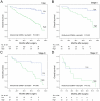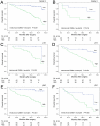Increased intratumoral neutrophil in colorectal carcinomas correlates closely with malignant phenotype and predicts patients' adverse prognosis
- PMID: 22295111
- PMCID: PMC3266280
- DOI: 10.1371/journal.pone.0030806
Increased intratumoral neutrophil in colorectal carcinomas correlates closely with malignant phenotype and predicts patients' adverse prognosis
Abstract
Background: Substantial evidence suggests that the presence of inflammatory cells plays a critical role in the development and/or progression of human tumors. Neutrophils are the common inflammatory cells in tumors; however, the infiltration of intratumoral neutrophils in colorectal carcinoma (CRC) and its effect on CRC patients' prognosis are poorly understood.
Methodology/principal findings: In this study, the methods of tissue microarray and immunohistochemistry (IHC) were used to investigate the prognostic significance of intratumoral CD66b+ neutrophil in CRC. According to receiver operating characteristic curve analysis, the cutoff score for high intratumoral CD66b+ neutrophil in CRC was defined when the mean counts were more than 60 per TMA spot. In our study, high intratumoral CD66b+ neutrophil was observed in 104/229 (45.4%) of CRCs and in 29/229 (12.7%) of adjacent mucosal tissues. Further correlation analysis showed that high intratumoral neutrophil was positively correlated with pT status, pM status and clinical stage (P<0.05). In univariate survival analysis, a significant association between high intratumoral neutrophil and shortened patients' survival was found (P<0.0001). In different subsets of CRC patients, intratumoral neutrophil was also a prognostic indicator in patients with stage II, stage III, grade 2, grade 3, pT1, pT2, pN0 and pN1 (P<0.05). Importantly, high intratumoral neutrophil was evaluated as an independent prognostic factor in multivariate analysis (P<0.05).
Conclusions/significance: Our results provide evidence that increased intratumoral neutrophil in CRC may be important in the acquisition of a malignant phenotype, indicating that the presence of intratumoral neutrophil is an independent factor for poor prognosis of patients with CRC.
Conflict of interest statement
Figures




Similar articles
-
Neutrophil infiltration is a favorable prognostic factor in early stages of colon cancer.Hum Pathol. 2017 Oct;68:193-202. doi: 10.1016/j.humpath.2017.08.028. Epub 2017 Sep 4. Hum Pathol. 2017. PMID: 28882699
-
High myeloperoxidase positive cell infiltration in colorectal cancer is an independent favorable prognostic factor.PLoS One. 2013 May 29;8(5):e64814. doi: 10.1371/journal.pone.0064814. Print 2013. PLoS One. 2013. PMID: 23734221 Free PMC article.
-
Intratumoral neutrophils: a poor prognostic factor for hepatocellular carcinoma following resection.J Hepatol. 2011 Mar;54(3):497-505. doi: 10.1016/j.jhep.2010.07.044. Epub 2010 Oct 1. J Hepatol. 2011. PMID: 21112656
-
Prognostic effect of intratumoral neutrophils across histological subtypes of non-small cell lung cancer.Oncotarget. 2016 Nov 1;7(44):72184-72196. doi: 10.18632/oncotarget.12360. Oncotarget. 2016. PMID: 27708229 Free PMC article.
-
[Emerging roles of neutrophils in the prognosis of colorectal cancer].Rev Med Inst Mex Seguro Soc. 2024 Nov 4;62(6):1-7. doi: 10.5281/zenodo.13306792. Rev Med Inst Mex Seguro Soc. 2024. PMID: 39570812 Review. Spanish.
Cited by
-
Identification and characterization of ATM founder mutation in BRCA-negative breast cancer patients of Arab ethnicity.Sci Rep. 2023 Nov 27;13(1):20924. doi: 10.1038/s41598-023-48231-0. Sci Rep. 2023. PMID: 38017116 Free PMC article.
-
Bacteria colonization in tumor microenvironment creates a favorable niche for immunogenic chemotherapy.EMBO Mol Med. 2024 Feb;16(2):416-428. doi: 10.1038/s44321-023-00022-w. Epub 2024 Jan 15. EMBO Mol Med. 2024. PMID: 38225455 Free PMC article.
-
SPOCK1 and POSTN are valuable prognostic biomarkers and correlate with tumor immune infiltrates in colorectal cancer.BMC Gastroenterol. 2023 Jan 7;23(1):4. doi: 10.1186/s12876-022-02621-2. BMC Gastroenterol. 2023. PMID: 36611136 Free PMC article.
-
Absolute Neutrophil Count Levels among Degree of Differentiation and Tumor Location in Colorectal Cancer Patients in Medan.Open Access Maced J Med Sci. 2019 Oct 14;7(20):3472-3474. doi: 10.3889/oamjms.2019.443. eCollection 2019 Oct 30. Open Access Maced J Med Sci. 2019. PMID: 32002077 Free PMC article.
-
Role of Neutrophils in Anti-Tumor Activity: Characteristics and Mechanisms of Action.Cancers (Basel). 2025 Apr 11;17(8):1298. doi: 10.3390/cancers17081298. Cancers (Basel). 2025. PMID: 40282474 Free PMC article. Review.
References
-
- O'Connell JB, Maggard MA, Ko CY. Colon cancer survival rates with the new American Joint Committee on Cancer sixth edition staging. J Natl Cancer Inst. 2004;96:1420–1425. - PubMed
-
- You WC, Jin F, Devesa S, Gridley G, Schatzkin A, et al. Rapid increase in colorectal cancer rates in urban Shanghai, 1972–97, in relation to dietary changes. J Cancer Epidemiol Prev. 2002;7:143–146. - PubMed
-
- Obrand DI, Gordon PH. Incidence and patterns of recurrence following curative resection for colorectal carcinoma. Dis Colon Rectum. 1997;40:15–24. - PubMed
-
- Zafirellis K, Agrogiannis G, Zachaki A, Gravani K, Karameris A, et al. Prognostic significance of VEGF expression evaluated by quantitative immunohistochemical analysis in colorectal cancer. J Surg Res. 2008;147:99–107. - PubMed
-
- Mantovani A. Cancer: Inflaming metastasis. Nature. 2009;457:36–37. - PubMed
Publication types
MeSH terms
Substances
LinkOut - more resources
Full Text Sources
Medical
Research Materials
Miscellaneous

